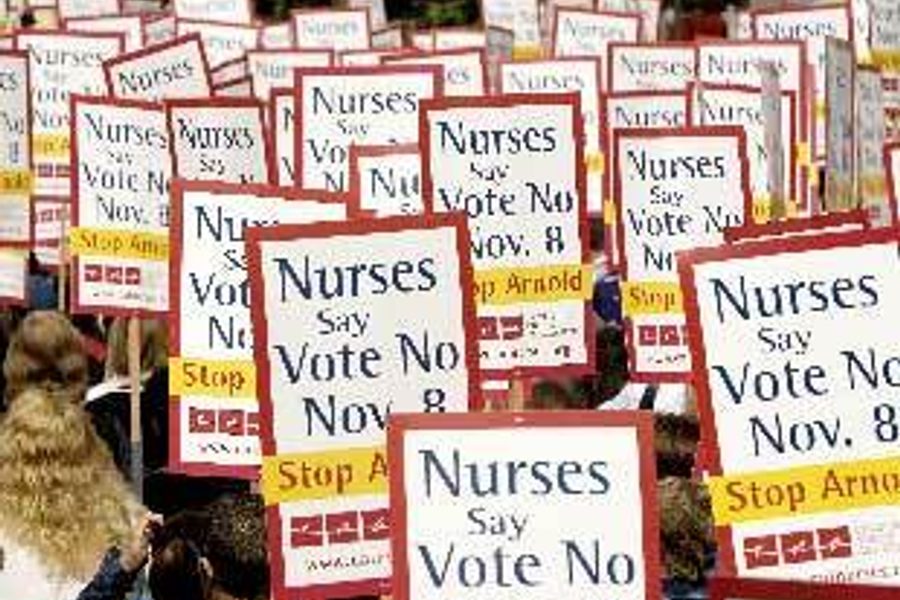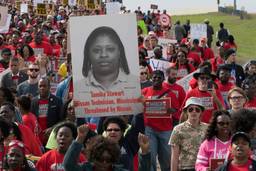The Healthcare Union War
Tensions between the California Nurses Association and SEIU escalate at the Labor Notes conference
David Moberg

As more than 1,000 labor union activists gathered in Dearborn, Mich., last weekend for the biennial conference organized by the magazine, Labor Notes, a passionate argument between competing health care unions coursed through the meeting. But by evening, the dispute turned ugly and physical. And the stakes in the dispute cranked up another notch.
On one side were nurses and leaders from the California Nurses Association/National Nurses Organizing Committee (CAN/NNOC); on the other, staff and nurses with the Service Employees International Union (SEIU).
SEIU supporters condemned CNA/NNOC for distributing leaflets on the eve of a representation vote for roughly 8,000 hospital workers at a chain of Catholic hospital in Ohio last month. After Ohio hospital workers received the leaflets attacking SEIU and the arrangement the union struck with management for an election, SEIU called off the vote.
“What would ever possess a union, CNA, to come to Ohio and destroy something we’d worked so hard to build?” Cinncinnati nurse Susan Horn asked plaintively.
But CNA argued that the election – formally requested by management, not the union, as part of a deal to guarantee management neutrality – was so flawed that it deserved to be challenged. And if SEIU really had support from workers, CNA argues, it could have won the election despite the leaflets.
“When a union election is called by the hospital, you have to question what that means,” says Geri Jenkins, a member of the CAN/NNOC Council of Presidents. “Is it a deal to do business, or a voice for workers? Fundamentally, what we’ll lose [with such deals] is the right to advocate for our patients.”
The debates over neutrality agreements – and the propriety of CNA’s actions – are the kind of heartfelt discussions over labor strategy that often occur at the conventions called by Labor Notes, which often irks union leaders by supporting rank-and-file opposition groups that push for more militancy or democracy.
But as the Saturday night fundraising banquet was about to start, a crowd of purple-clad SEIU staff and members gathered outside the Hyatt Regency in Dearborn. SEIU claimed there were around 800. Other observers estimated as few as 150 to 200. But someone from inside the hotel let them through the locked doors, and they rushed past hotel security to try to enter the banquet hall. CNA Executive Director Rose Ann DeMoro had been scheduled to speak, but she had cancelled earlier in the day, citing the need to stay in California to deal with what she called the “harassment” and “stalking” of CNA leaders at home and work by SEIU staff.
According to eyewitness accounts, the most aggressive leaders of the group – some with purple bandanas on their faces – hit and kicked some of the Labor Notes staff and supporters who were blocking the doors. But another line of conference attendees locked arms to hold back the rest of the crowd. At least one woman, a retired auto worker, fell as an SEIU protester tried to slip past her and cut a gash in her head.
Bill Fletcher, former assistant to the president of SEIU, witnessed part of the standoff. “Nothing I saw leads me to believe the intent [of the SEIU people] was to harm, but the intent was clearly to disrupt the gathering by almost any means necessary,” he says. “This was not just a protest.” He was troubled to find that some protesters seemed to have no idea why they were involved in the action. And he argues that SEIU – which other unions criticize for raiding their members, just as several health care unions criticize CNA for its raids on nurses – lost much of the support it may have had.
“I’m against raids, and I was kind of uneasy about what CNA was doing in Ohio,” says Fletcher, who also was assistant to AFL-CIO President John Sweeney. “But whatever sympathy SEIU had was gone, evaporated like dew in the morning, and replaced by a disgust that this would have happened.”
SEIU leaders defended and celebrated the action as a labor victory, initially calling it peaceful. Sweeney himself weighed in Tuesday with a harsh rebuke to the union he formerly led. “There is no justification – none – for the violent attack orchestrated by SEIU at the Labor Notes conference in Detroit,” Sweeney’s press statement read.
Sweeney, who said that he had been trying to bring the two unions together to resolve the dispute, also decried SEIU’s call for its local unions to withhold their solidarity charter dues that permit them to participate in central labor councils despite having left the AFL-CIO.
SEIU in turn described the event as a “scuffle [that] occurred between protestors trying to enter [the banquet hall] and conference organizers trying to keep them out.” SEIU claims that “protestors were being pushed, shoved, and even assaulted by conference participants.”
The dispute risks escalating further. Both SEIU and CNA have sent mailings to thousands of nurses – including nurses in other unions and others who unions are currently trying to organize – attacking each other. CNA is currently pushing for decertification of SEIU in Las Vegas and Los Angeles hospitals. According to an SEIU staffer’s letter of resignation, SEIU is planning decertifcation campaigns against 10 to 15 CNA units in California.
“Is raiding that bad?” asks DeMoro. “I don’t know. Should workers be able to get out? Basically, yes, if workers want out of a union, they should be able to.” What about SEIU attempting to raid CNA? “They’re welcome to do so.”
CNA, which organizes only registered nurses into a craft or professional union, emphasizes combative member involvement in representing both nurses and patient rights. SEIU promotes an industrial union covering all health care workers, and it saw the Ohio agreement as a possible first step to large-scale organizing in Catholic hospitals nationwide. But some of its agreements with employers have sharply limited workers’ power and emphasized the union’s cooperation with management.
“This is so completely inevitable, absolutely predictable,” DeMoro says. “I saw Ohio as a template for where [SEIU was] going with organizing overall. They’ve given up on worker involvement in unions. [SEIU President] Andy [Stern] started thinking workers shouldn’t be involved in contracts or representation. … Ohio is the next step. Now you don’t even have workers involved in selecting the union.”
The danger of the health care union war is that nurses may be turned off to joining any union, while energy and resources that could be spent against management or for national health insurance will instead be directed toward combat with other unions. But a resolution to the conflict doesn’t look to be coming soon.
David Moberg, a former senior editor of In These Times, was on staff with the magazine from when it began publishing in 1976 until his passing in July 2022. Before joining In These Times, he completed his work for a Ph.D. in anthropology at the University of Chicago and worked for Newsweek. He received fellowships from the John D. and Catherine T. MacArthur Foundation and the Nation Institute for research on the new global economy.








